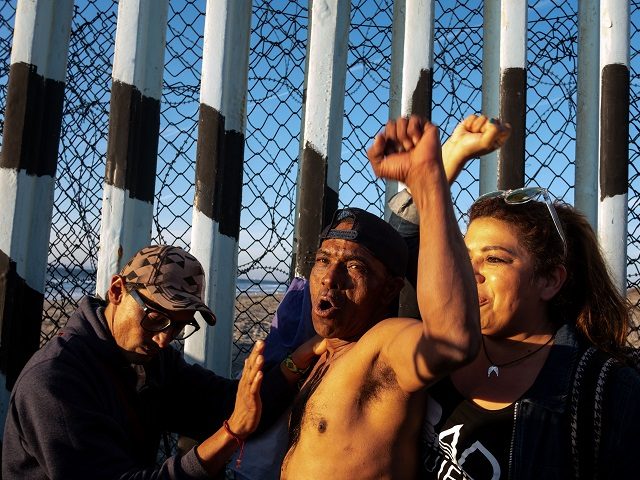This morning’s key headlines from GenerationalDynamics.com
- Thousands of migrants overwhelm Mexican cities to Tijuana
- People of Mexico are increasingly split between xenophobia and sympathy toward migrants
Thousands of migrants overwhelm Mexican cities to Tijuana

Honduran migrants arrive at US border fence (Reuters)
The United States closed off northbound traffic for several hours at the border crossing from Tijuana Mexico into San Ysidro, California. One of two pedestrian crossings were also closed to prevent a mass rush of migrants across the border.
This is the busiest border crossing from Mexico to the United States. Closing the border crossing inconvenienced many of the about 110,000 people who cross the border every day in 40,000 vehicles to commute to work.
The border crossing had to be closed for several hours to permit the installation of movable, wire-topped barriers.
Tensions at the border have been building as nearly 3,000 migrants from a caravan arrived in Tijuana in recent days, the first of a series of migrant caravans that organized in October. The federal government estimates the number of migrants could soon swell to 10,000 as additional migrant caravans arrive. The migrants are arriving from Central American countries.
The migrants are planning to apply for asylum in the United States at the San Ysidro portal. However, U.S. border inspectors are processing only about 100 asylum claims per day.
Tijuana officials converted a municipal gymnasium and recreational complex into a shelter to keep migrants out of public spaces. The city’s privately run shelters have a maximum capacity of 700. The municipal complex can hold up to 3,000.
Tijuana Mayor Juan Manuel Gastelum has called the migrants’ arrival an “avalanche” that the city is ill-prepared to handle, calculating that they will be in Tijuana for at least six months as they wait to file asylum claims. Gastelum has appealed to the federal government for more assistance, but so far the government in Mexico City has refused.
Because Tijuana’s resources are overwhelmed, cities “upstream” along the caravan route are slowing down the flow.
The city of Mexicali is 100 miles away along the highway to Tijuana. There are 1,300 Honduran migrants crowded into shelters in Mexicali waiting to travel to Tijuana. However, Mexican police this weekend blocked their buses from proceeding to Tijuana because the latter city is already full of migrants.
The group began as 7,000 migrants who left San Pedro Sula, Honduras, about a month ago, fleeing poverty, gang violence, and lawlessness. The 1,300 who arrived in Mexicali are considering options, including making the extremely dangerous journey to Tijuana on foot. Hundreds more are expected in Mexicali next week.
Local officials in Guadalajara, the capital city of Jalisco state, about 1,200 miles south of Tijuana, were apparently played a cruel trick by federal government officials. The government of Jalisco had promised to provide transportation to Nayarit, 120 miles away, for nearly 6,000 migrants staying in Guadalajara. Instead, they provided buses for only 2,000, and then forced them off the bus on the outskirts of Jalisco, still over 62 miles away from the closest town in Nayarit. Then they blocked the other 3,000 migrants from receiving food packages, saying that “they are only for those who are leaving on the buses.” Instead, the state will provide water, some food, and escorts at nine points along the main highway leading through the state to help ensure the migrants don’t have to stop.
And in Mexico City, authorities closed a shelter at a sports complex that had once housed thousands of migrants. The remaining 650 migrants from the third, mainly Salvadoran, caravan were taken to a Roman Catholic pilgrimage hostel at the Basilica of Guadalupe. The city said the hostel would be warmer. AP and Palm Springs Desert Sun (18-Nov) and Regeneración Radio (15-Nov)
People of Mexico are increasingly split between xenophobia and sympathy toward migrants
Although most Mexicans have been sympathetic and supportive toward the central American migrants, and have provided food and water to them along their travels, there is a growing minority of Mexicans, especially in the northern states close to the U.S. border, who are expressing hostile xenophobic attitudes towards the migrants.
Over the weekend, a few hundred Tijuanenses gathered in Tijuana’s high-end Rio area to protest the migrants. Demonstrators held signs reading “No illegals,” “No to the invasion,” and “Mexico First.” Many wore the country’s red, white, and green national soccer jersey and vigorously waved Mexican flags. The crowd often slipped into chants of “Ti-jua-na!” and “Me-xi-co!” They sang the national anthem several times. One was quoted as saying, “We want the caravan to go, they are invading us. They should have come into Mexico correctly, legally, but they came in like animals.”
A Facebook page called “Tijuana against the migrant caravan” promotes the rejection of migrants. Five days after it was created, the group already had 4,000 followers. Through social media, local citizens are requesting for foreigners to be taken out of the city with slogans such as “Defend your country, kill a Honduran.” The group members argued that migrants were criminals and that there were drug addicts, gang members, and even murderers among their ranks.
As long-time readers are aware, nationalism and xenophobia have been increasing in countries around the world, as the world goes deeper into a generational Crisis era, and the survivors of World War II, who understood the dangers of nationalism and xenophobia, are now all pretty much gone.
At the same time, as the global population has been growing faster than the global supply of food and other resources, poverty has been increasing, leading to mass migrations in many parts of the world, including Latin America, Europe, Africa, and Asia. Some of these mass migrations are intentionally caused by leaders of countries, including Syria, Myanmar (Burma), Venezuela, and Democratic Republic of Congo (DRC). These mass migrations tax the resources of the countries receiving the migrants and might lead to a regional war that could spiral into a larger war at any time. These mass migrations are expected to become larger each year.
With regard to the influx of Hondurans into Mexico, there has not been a major war between Honduras and Mexico in recent centuries, so the bouts of anti-Honduran xenophobia that are occurring today in Tijuana and elsewhere are unlikely to spiral into something more serious. NPR and El Universal and Guardian (London)
Related Articles
- Venezuela’s refugees crisis soars, as economic disaster reaches new levels (09-Nov-2018)
- Latin American countries open their borders to migrants from Socialist Venezuela (06-Sep-2018)
- Thousands of Haitians living in Miami scheduled for deportation in January (14-Oct-2017)
- US will deport tens of thousands of Haitian immigrants surging toward California (25-Sep-2016)
- Thousands of migrants flee to Canada, fearing deportation in the US (04-Aug-2017)
- History of Haiti (04-Mar-2004)
KEYS: Generational Dynamics, San Ysidro, California, Mexico, Tijuana, Juan Manuel Gastelum, Mexicali, San Pedro Sula, Honduras, el Salvador, Guadalajara, Jalisco, Nayrit, Mexico City, Basilica of Guadalupe, Syria, Myanmar, Burma, Venezuela, Democratic Republic of Congo, DRC
Permanent web link to this article
Receive daily World View columns by e-mail

COMMENTS
Please let us know if you're having issues with commenting.